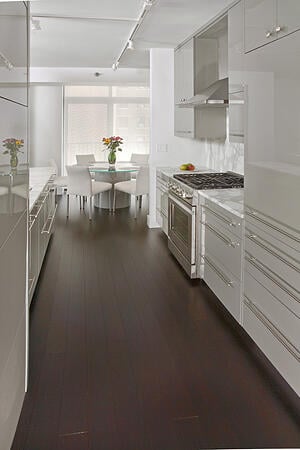 Are you replacing the flooring in your Chicago kitchen remodel? If so, you may find yourself debating between hardwood and bamboo options, the latter of which receives a fair amount of press as the result of its advertised sustainability – and durability.
Are you replacing the flooring in your Chicago kitchen remodel? If so, you may find yourself debating between hardwood and bamboo options, the latter of which receives a fair amount of press as the result of its advertised sustainability – and durability.
Does Your Chicago Kitchen Remodeling Project Call for Hardwood or Bamboo?
There are definitely advantages and disadvantages to both hardwood and bamboo flooring, so it’s worth it to do a side-by-side comparison. While they have a similar look and feel – there are differences and ultimately, they’ll drive your final decision.
Sustainability
We’re going to start here because most people interested in bamboo are ultimately interested in sustainable products. Be careful with that one, because bamboo flooring may not be as sustainable as you think – and currently there are no third-party ratings or fair-trade certifications (like the FSC) you can rely on to prioritize one bamboo product over another.
While bamboo does grow exponentially faster than trees, the large majority of it is grown in Southeast Asia, meaning considerable energy (via fossil fuels) is spent shipping it here. In contrast, there are many species of hardwoods grown right here in the USA.
Also, the process required to make bamboo into a solid flooring material uses more resources than required to turn a log into planks. And, along those lines, bamboo products require adhesives, mix binders, and other chemicals/processing that have formaldehyde in the mix.
In some cases, wood flooring products bearing and National FSC approval, and using low- to no-voc chemicals/finishes, are equally or more sustainable than bamboo options. That being said, bamboo’s ability to be reused and recycled, along with its fast growth-harvest times, still make it a LEED-recognized, eco-friendly building material.
Durability
Durability is a priority to be sure, particularly if you have a kitchen that’s inhabited by children or pets.
With bamboo, hardness ratings range from 1000 to 1100 (carbonized bamboo) to 1300 to 1400 (natural bamboo). The carbonization process is used to darken the bamboo – giving it an appearance that mimics stained hardwood, whereas the natural bamboo flooring products are very light-blonde to golden in appearance. Either way, bamboo is considered very durable – but is more prone to scratching or dings than the hardest hardwood options.
Hardwood hardness ratings vary according to species, with softer woods being more prone to scratches and dings, and harder species (ratings of 2500+) being more durable.
Read, What Are Some Recommended Types of Hardwood Flooring?, to read about the top hardwood species on our list.
Variability in look
Because bamboo is a woody-reed, it’s “grains” so-to-speak run consistent and parallel with one another. This makes for a very clean and streamlined look – especially popular with contemporary and/or modern kitchen design enthusiasts. However, they're not graded or sorted by pattern the way wood is – so there can notable variability from plank-to-plank – a bonus for some and a distracting feature for others.
Hardwood, on the other hand, has a larger variety of wood grain patterns based on species, giving homeowners a choice in the complexity of pattern. However, because hardwood is graded and sorted, there is greater consistency from plank-to-plank.
It used to be that bamboo had far fewer “finish” options – but now, as carbonization techniques improve with innovation, you can purchase bamboo floors that range from an ashy white, through natural blondes and golds, and into the dark- and very-dark finish arena – similar to hardwood.
Are you debating between hardwood and bamboo flooring for your Chicago kitchen remodeling project? Feel free to contact us here at Kitchens & Baths Unlimited. Our design team is happy to help you weigh the pros and cons – and discuss your overall design plans – to help you determine the optimal choice for your household.



